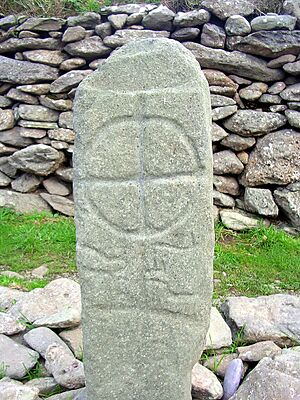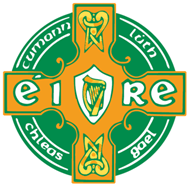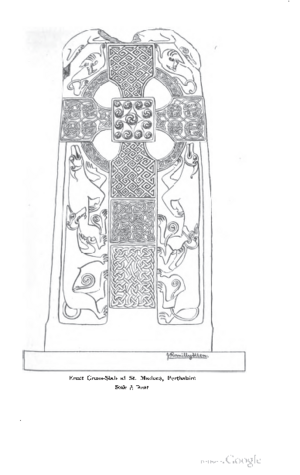Celtic cross facts for kids

The Celtic cross is a unique Christian cross that has a circle, called a nimbus, around where the arms of the cross meet. This special design first appeared in Ireland and Britain during the Early Middle Ages. It became very popular as large stone crosses, known as high crosses. These crosses were built across Ireland and Britain, especially in areas where Irish missionaries spread Christianity. Most of these tall stone crosses were made between the 9th and 12th centuries.
The Celtic cross is a key part of Insular art, which is art from Ireland and Britain in the early Middle Ages. It looks like a regular Latin cross but with a ring around the middle. Experts aren't completely sure how it started, but it's linked to older crosses that also had rings. The Celtic cross became popular again in the 1800s during a time called the Celtic Revival. That's when it got its name "Celtic cross." This cross often has beautiful patterns like interlace designs. It is still used today for graves and other decorations, and it's found all over the world, not just in Ireland.
Contents
History of the Celtic Cross
Early Designs and Origins

Crosses with rings, similar to older designs from Europe, started appearing in Ireland and Scotland. You can see them on carved stone slabs and old treasures like the Ardagh chalice. But the Celtic cross became most famous when it was used for huge stone high crosses. These tall monuments are a special kind of Insular art.
These high crosses first appeared around the 9th century. They usually look like a cross with a ring, standing on a stepped base. The ring actually makes the cross stronger, helping the arms not break off. There are a few ideas about how this design started. Some people think the ring was first used to support the arms of wooden crosses. Others believe it came from ancient art that showed a wheel or circle around a head. Some also think it was inspired by early Coptic crosses from Egypt.
However, many scholars believe the ring comes from earlier Christian art. These "cosmological crosses" had a ring that represented the sky or the universe. This idea was important in a poem called Carmen Paschale, which was known in Ireland by the 7th century.
Where the First High Crosses Appeared
It's not clear exactly where the first high crosses were made. The earliest ones date back to around the 9th century. They are found in two main places: Ahenny in Ireland and Iona, an Irish monastery off the coast of Scotland. The crosses at Ahenny are generally thought to be older.
However, some think the St. Johns Cross at Iona might have been the very first high cross. Iona was a very important religious place. Its influence might have inspired the crosses at Ahenny and other ringed crosses found in Pictish stones in Scotland.
Famous Ancient Celtic Crosses
Many old standing crosses in Ireland and areas influenced by Ireland are shorter and thicker than similar crosses found in England. Famous Irish examples include the Cross of Kells, Ardboe High Cross, and the crosses at Monasterboice. You can also see the Cross of the Scriptures at Clonmacnoise. In Scotland, important crosses are found at Iona and the Kildalton Cross. This one might be the oldest well-preserved Celtic cross.
You can also find old stone crosses in Cornwall (like St Piran's cross) and Wales. Other stone crosses are in northern England and Scotland, where they mix with the Anglo-Saxon cross-making style, like the Ruthwell Cross. Sadly, many crosses in Britain were destroyed during the Protestant Reformation. Around the year 1200, the main period of building these large crosses in Ireland came to an end.
Legend of Saint Patrick
A popular story in Ireland says that Saint Patrick or perhaps Saint Declan brought the Christian cross to Ireland. However, there are no examples of Celtic crosses from that very early time. It's often said that Saint Patrick combined the Christian cross with the sun cross to help pagan people understand Christianity. By linking the cross to the sun, which was seen as life-giving, he made it more appealing to them. Another idea is that placing the cross on top of the circle showed that Christ was more powerful than the pagan sun gods.
Modern Popularity of the Celtic Cross
The Celtic Revival

In the mid-1800s, there was a time called the Celtic Revival. During this period, people in Ireland became very interested in their history and culture. This led to more Celtic crosses being made and used. In 1853, copies of several old high crosses were shown at an exhibition in Dublin. Then, in 1857, a book by Henry O'Neill showed pictures of many ancient Irish crosses. These events made people even more interested in the Celtic cross as a symbol of Irish heritage.
New designs of the high cross started appearing on graves in Dublin in the 1860s. From Dublin, this trend spread across Ireland and beyond. Since the Celtic Revival, the ringed cross has become a symbol of Celtic identity, in addition to its religious meaning.
Modern interest in the Celtic cross also grew because of Alexander and Euphemia Ritchie. They worked on the Isle of Iona in Scotland from 1899 to 1940. They made the Celtic cross popular in jewelry, and it's still a common design in fashion today.
Images for kids
-
Cross near Peebles, Scotland
-
Modern Celtic cross on a war monument in Limburg-Dietkirchen, Germany
See also
 In Spanish: Cruz celta para niños
In Spanish: Cruz celta para niños







